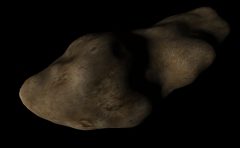Difference between revisions of "1620 Geographos"
Jump to navigation
Jump to search
m (Arvil moved page 1998 KY26 to 1620 Geographos: Move to article page.) |
(Added gallery.) |
||
| (2 intermediate revisions by the same user not shown) | |||
| Line 1: | Line 1: | ||
| − | {| cellpadding="2" cellspacing="0" style="margin:25px 0 0 10px; border:3px solid lightsteelblue;width:250px; font-size: | + | {| cellpadding="2" cellspacing="0" style="margin:25px 0 0 10px; border:3px solid lightsteelblue;width:250px; font-size:90%; font-family:'Arial','Helvetica'; float: right; clear: right;"Template in Orbiter" |
| − | !bgcolor="lightsteelblue" colspan="2" align="center" | | + | !bgcolor="lightsteelblue" colspan="2" align="center" |1620 Geographos |
|- | |- | ||
| − | |colspan="2" align="center"|[[Image: | + | |colspan="2" align="center"|[[Image:1620 Geographos.png|240px]] |
|- | |- | ||
| − | |colspan="2" align="center"|''' | + | |colspan="2" align="center"|'''Geographos in Orbiter''' |
|- | |- | ||
!bgcolor="lightsteelblue" colspan="2"|Designation | !bgcolor="lightsteelblue" colspan="2"|Designation | ||
|- | |- | ||
| − | |Name||align="right"| | + | |Name||align="right"|1620 Geographos |
|- | |- | ||
| − | |Reference body||align="right"|Sun | + | |width="30%"|Reference body||align="right" width="30%"|Sun |
|- | |- | ||
| − | |Number of satellites||align="right" width="30%"|0 | + | |width="30%"|Number of satellites||align="right" width="30%"|0 |
|- | |- | ||
| − | !bgcolor="lightsteelblue" colspan="2"|Planetary mean | + | !bgcolor="lightsteelblue" colspan="2"|Planetary mean orbits |
|- | |- | ||
| − | |Epoch||align="right"|2006 | + | |width="30%"|Epoch||align="right" width="50%"|2006 |
|- | |- | ||
| − | |Semimajor axis (a)||align="right" | | + | |width="30%"|Semimajor axis (a)||align="right" width="50%"| 186315638173 km<br>(1.24544311568598 AU) |
|- | |- | ||
| − | |Eccentricity (e)||align="right"|0. | + | |width="30%"|Eccentricity (e)||align="right" width="30%"| 0.335415102834536 |
|- | |- | ||
| − | |Inclination (i)||align="right"| | + | |width="30%"|Inclination (i)||align="right" width="30%"|0.232845464045468 radian<br>(13.3410623685705°) |
|- | |- | ||
| − | |Longitude of the ascending node (LAN, ☊)||align="right"| | + | |width="30%"|Longitude of the ascending node (LAN, ☊)||align="right" width="30%"|5.88689533166951 radian<br>337.29425693993° |
|- | |- | ||
| − | |Longitude of periapsis (ϖ)||align="right"| | + | |width="30%"|Longitude of periapsis (ϖ)||align="right" width="30%"|10.7178284350264 radian<br>614.086334872317° |
|- | |- | ||
| − | |Mean longitude (L)||align="right"| | + | |width="30%"|Mean longitude (L)||align="right" width="30%"|12.5060362286656 radian<br>716.543094340244° |
| + | |- | ||
| + | !bgcolor="lightsteelblue" colspan="2"|Rotational Elements | ||
| + | |- | ||
| + | |width="30%"|Sidereal Rotation Period||align="right" width="50%"|18802.8 seconds<br>(5.223 hours) | ||
| + | |- | ||
| + | |width="30%"|Sidereal Rotation Offset||align="right" width="50%"|0 | ||
| + | |- | ||
| + | |width="30%"|Obliquity||align="right" width="30%"|0.1 radians<br>0° | ||
|- | |- | ||
!bgcolor="lightsteelblue" colspan="2"|Selected physical parameters | !bgcolor="lightsteelblue" colspan="2"|Selected physical parameters | ||
|- | |- | ||
| − | |width="30%"|Mean radius||align="right"| | + | |width="30%"|Mean radius||align="right" width="30%"| 3450 m |
|- | |- | ||
| − | |Mass||align="right"| | + | |width="30%"|Mass||align="right" width="30%"|4×10<su>12</sup> kg |
|- | |- | ||
| − | + | |width="30%"|Equatorial gravity||align="right" width="30%"|0.000022 m/s<sup>2</sup> | |
|- | |- | ||
| − | | | + | |width="30%"|Escape velocity||align="right" width="30%"| 0.0004 m/s |
|- | |- | ||
| − | | | + | |width="30%"|Gravity at surface||aligh="right" width="30%"|Geographos 1%<br>Sun 99% |
|- | |- | ||
| − | | | + | |width="30%"|Note||align="right" width="30%"|*Elements given are from Geographos.cfg file. |
| − | |||
| − | |||
|} | |} | ||
| Line 54: | Line 60: | ||
}} | }} | ||
| − | ''' | + | '''1620 Geographos''' is a Near-Earth object discovered in 1951 by [[w:Albert George Wilson|Albert George Wilson]] and [[w:Rudolph Minkowski]] at [[w:Palomar Observatory|Palomar]] and is named in honor of the [[w:National Geographic Society]]. |
| − | |||
| − | |||
| − | |||
| − | |||
| + | Geographos was to be visited by the [[w:Clementine mission]], failed to reach the body. | ||
== Gallery == | == Gallery == | ||
<gallery widths="200" heights="200"> | <gallery widths="200" heights="200"> | ||
| − | + | Animation_of_1620_Geographos_orbit.gif|Animation of the orbit of Geographos as compared to [[Venus]], [[Earth]] and [[Mars]] from 2010 to 2020.<br>From Wikimedia Commons. | |
| − | |||
</gallery> | </gallery> | ||
{{SolarSystem}} | {{SolarSystem}} | ||
| − | [[Category:Articles]] | + | [[Category:Articles|Geographos]] |
| − | [[Category:Celestial | + | [[Category:Celestial bodies|Geographos]] |
| − | [[Category:Solar System]] | + | [[Category:Solar System|Geographos]] |
| − | [[Category:Near-Earth objects]] | + | [[Category:Near-Earth objects|Geographos]] |
Revision as of 17:25, 21 May 2024
|
Project home: Asteroid Pack 1.00 |
1620 Geographos is a Near-Earth object discovered in 1951 by Albert George Wilson and w:Rudolph Minkowski at Palomar and is named in honor of the w:National Geographic Society.
Geographos was to be visited by the w:Clementine mission, failed to reach the body.
Gallery
| edit The Solar System | |
|---|---|
| Central star |
Sun (Sol) |
| Planets |
Mercury - Venus - Earth - Mars - Jupiter - Saturn - Uranus - Neptune |
| Natural satellites |
Moon - Phobos - Deimos - Io - Europa - Ganymede - Titan - more... |
| Add-ons |
Planets - Dwarf Planets - Small objects - Natural satellites - Alternative star systems |

